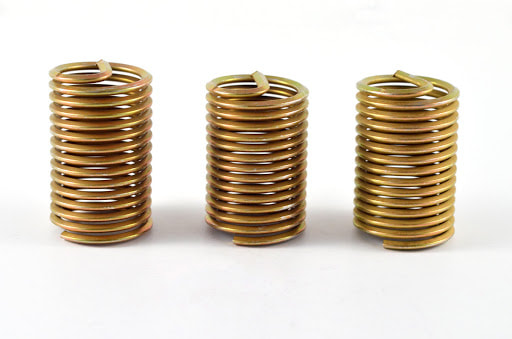Torsion springs
The use of torsion spring is to resist the twisting force or torque. This helically wound spring has arms that rotate about the spring’s central axis. These spring arms are available to get connected to any external component that applies a load to the spring. The load can be applied in the direction to decrease the spring’s diameter. Cloths pin make a good example of torsion spring.
The torsion springs are available in varied sizes and leg designs. When there is a need for high torque the effect can be created by the combined use of two joined torsion springs that are spaced adequately and this is called double torsion spring. The double torsion spring has two coil sets – one coil set is coiled in right-hand direction and the other one is coiled in left-hand direction producing a torque that is total of both. For more customization in the torsion spring designs, you will need to consult an engineer.
The main use of torsion springs is in swing-down tailgates, garage doors, clothespins, counterbalances, etc.
Torsion springs are helical shaped and they exert a torque or rotatory force. The ends of torsion spring are joined to other components and when these components try to move around the center of the spring then the spring tries to bring them back in the original position.
Mostly the torsion spring is subjected to bending stress rather than torsional stress.
This spring is designed to resist when a force is rotationally applied to the spring. These springs get twisted when the outside force is applied to them, unlike other springs that are either extended or compressed.
Hence, the spring rotates through an angle depending upon the applied force. The angular energy is stored and released by the spring.
Depending on the usage of a torsion spring, it can be designed to operate both clockwise and anticlockwise and this determines the direction in which they are coiled.
Torsion spring performs best after being supported by a rod. This rod is known as a mandrel. The engineer must consider the effects of friction and also the arm deflection on the torque when he’s working on the design of a torsion spring.
The torsion springs are available in varied sizes and leg designs. When there is a need for high torque the effect can be created by the combined use of two joined torsion springs that are spaced adequately and this is called double torsion spring. The double torsion spring has two coil sets – one coil set is coiled in right-hand direction and the other one is coiled in left-hand direction producing a torque that is total of both. For more customization in the torsion spring designs, you will need to consult an engineer.
The main use of torsion springs is in swing-down tailgates, garage doors, clothespins, counterbalances, etc.
Torsion springs are helical shaped and they exert a torque or rotatory force. The ends of torsion spring are joined to other components and when these components try to move around the center of the spring then the spring tries to bring them back in the original position.
Mostly the torsion spring is subjected to bending stress rather than torsional stress.
This spring is designed to resist when a force is rotationally applied to the spring. These springs get twisted when the outside force is applied to them, unlike other springs that are either extended or compressed.
Hence, the spring rotates through an angle depending upon the applied force. The angular energy is stored and released by the spring.
Depending on the usage of a torsion spring, it can be designed to operate both clockwise and anticlockwise and this determines the direction in which they are coiled.
Torsion spring performs best after being supported by a rod. This rod is known as a mandrel. The engineer must consider the effects of friction and also the arm deflection on the torque when he’s working on the design of a torsion spring.
In the end
By using good-quality industrial springs you can ensure the long life of your equipment. At the same time, the correct and detailed information about the most commonly used spring types will guide you to use them efficiently and deepen your understanding of how these springs function and what customization can be done to ensure you get the desired results.

Comments
Post a Comment